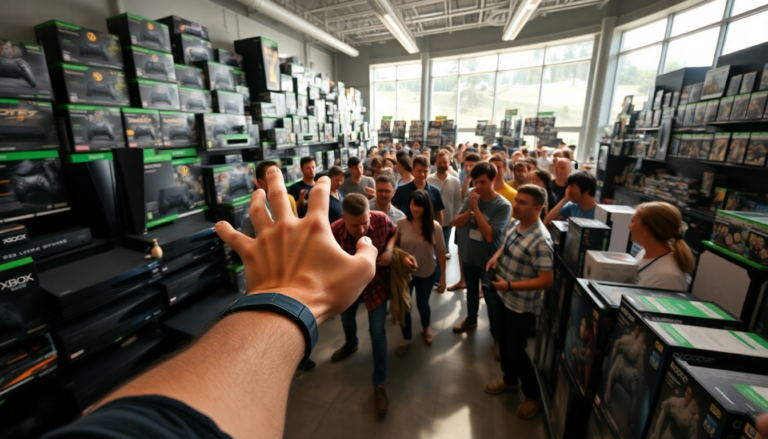Argomenti trattati
Welcome to the wonderfully chaotic world of ninth-generation gaming consoles, which, let’s face it, was thrown into the blender of crisis right from the start. When Microsoft and Sony rolled out their shiny new toys in late 2020, they probably thought they were launching the next big thing. However, instead, they were more like a couple of drunks stumbling into a bar, knocking over the drinks of everyone in the room. The Xbox Series X, Series S, and PlayStation 5 burst onto the scene, boasting promises of faster graphics and loading times so quick they could make a cheetah look like it’s stuck in traffic. But did they deliver? Hardly.
What happened to the thrill of gaming?
The excitement of gaming has turned into a bitter joke. Sure, these consoles come with the bells and whistles of real-time ray tracing and 4K resolution—because who doesn’t want their virtual characters to look slightly less pixelated? It’s like putting lipstick on a pig. The Xbox Series S and PS5 Digital Edition even ditched the optical drive, embracing the digital age like a kid refusing to grow up. But let’s be honest, what good is a console if you can’t even find one on the shelves? The pandemic-induced chaos meant that gamers were left salivating, waiting for their fix while scalpers raked in the cash. And what’s the deal with the Nintendo Switch still hanging around like an uninvited guest at a party?
Console wars: A new kind of madness
Now, let’s talk about the so-called console wars. It used to be about who had the best games or the flashiest graphics. Now, it feels like a twisted episode of a reality show. Analysts were scratching their heads, wondering if we had reached the end of traditional console generations. With mid-generation redesigns and subscription services, like Microsoft’s Xbox Game Pass, it’s like watching a soap opera where no one knows who’s dating whom. Everyone’s playing nice, sharing games across platforms, and pretending that competition doesn’t exist. But let’s not kid ourselves; it’s all a façade to keep us hooked while they squeeze our wallets dry.
The pandemic: A wild card for console releases
Let’s not forget about the pandemic—the wild card that threw a wrench into everyone’s plans. When COVID-19 hit, both Microsoft and Sony had to pivot faster than a politician at a press conference. E3 2020 was canceled, leaving them with no stage to showcase their shiny new toys. Instead, they turned to online showcases, which felt more like a desperate plea than a grand reveal. By then, the hype had turned into a bitter aftertaste as they warned us of limited supplies. Who knew that a global pandemic would turn us into desperate gamers, praying for a miracle?
The PlayStation 5: A flawed masterpiece
Now, let’s take a closer look at the PlayStation 5. Released with a custom solid-state drive (SSD) architecture, it promised to eliminate loading times faster than you can say “gamer rage.” But was it enough to distract us from the endless shortages and the fact that many games still were not optimized for the new hardware? With a whopping 10.28 teraflops of processing power, the PS5 was shouting, “Look at me!” while developers were scratching their heads, wondering how to make it work. And the backward compatibility? Let’s just say it’s a half-hearted attempt at nostalgia.
Xbox Series X/S: More power, more problems
On the flip side, we have the Xbox Series X, which promised performance so powerful it could probably run a small country. With its Velocity Architecture and a stunning 12.155 teraflops, it was supposed to change the game. Yet, it finds itself in the same swirling vortex of supply issues. The Series S, marketed as the cheaper alternative, is often seen as the black sheep—good enough but hardly a showstopper. And while both consoles claim to have backward compatibility, it’s still a mixed bag of hit-or-miss titles that leave gamers feeling more frustrated than fulfilled.
The rise of handheld and cloud gaming
Oh, and let’s not forget the handheld gaming revolution. Enter the Steam Deck, a device that lets you play your favorite games on the go while making you feel like a tech-savvy genius—or a complete fool for buying into the hype. And what about cloud gaming? It’s the latest buzzword in the industry, promising the world while delivering more lag than a 90s dial-up connection. But hey, who needs a physical console when you can stream your games through a cloud service that barely works? It’s a beautiful disaster.
Virtual reality: A step into the bizarre
In the midst of all this chaos, virtual reality is trying to make a name for itself. The Meta Quest Pro and PlayStation VR2 are fighting for attention, but honestly, who has the time to strap a headset on when you’re still trying to get your hands on a PS5? It’s become a circus act, with each new device promising a revolutionary experience while ultimately leaving us feeling dizzy and slightly nauseous.
The future: Who the hell knows?
As we look towards the future, one can’t help but wonder where this chaotic path will lead. Will we ever see consoles on shelves without the hassle of dealing with scalpers? Can we expect gaming companies to deliver on their promises without the endless delays and mishaps? Or are we just stuck in this twisted game of consumer roulette? One thing’s for sure—this isn’t the end, but merely another chapter in the bizarre saga of gaming. And really, who doesn’t love a good mess?

